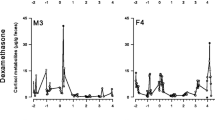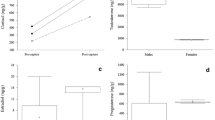Abstract
Twenty-one metabolites were detected in faecal samples collected after infusion of (14C)cortisol into the jugular vein of sheep, using high-performance liquid chromatography/radiometric analysis plus mass spectrometry. One group of metabolites had molecular weights of between 302 and 308, and another group of 350, which indicates that the substances have a C19O3 or a C21O4 structure. Therefore, an enzyme immunoassay against 5β-androstane-3α-o1-11,17-dione-17-CMO:BSA was established. Faecal samples were collected from 10 cows immediately after transport and then during a course in which non-invasive diagnostic procedures were being taught (course 1). For comparison, faeces were sampled from another 5 cows that were being used for teaching invasive procedures (course 2). Six cows from a university farm served as controls. In the animals used in course 1, the highest concentrations of cortisol metabolites were measured immediately after transport to the university (median value: 2.2 μmol/kg faeces). During the first 5 days at the university, the concentrations decreased to 0.52 μmol/kg (median) and remained at this level during the rest of the course. The median concentration in the samples that were taken during course 2 (collected about 2 months after transport) was 0.48 μmol/kg. There was no significant difference in the excretion of cortisol metabolites between these cows and the controls. We conclude from these data that, using the enzyme immunoassay against 5β-androstane-3α-o1-11,17-dione-17-CMO, we were able to detect transport/novel environment stress but not the potential disturbance that cows experience during diagnostic procedures.
Similar content being viewed by others
REFERENCES
Broom, D.M. and Johnson, K.G., 1993. Stress and Animal Welfare, (Chapman and Hall, London), 87-144
Clark, J.D., Rager, D.R. and Calpin, J.P., 1997. Animal well-being: II. Stress and distress. Laboratory Animal Science, 47, 571-579
Cooper, T.R., Trunkfield, H.R., Zanella, A.J. and Booth, W.D., 1989. An enzyme-linked immunosorbent assay for cortisol in the saliva of man and domestic farm animals. Journal of Endocrinology, 123, R13-R16
Goymann, W., Möstl, E., Van't Hof, T., East, M.L. and Hofer, H., 1999. Noninvasive fecal monitoring of glucocorticoids in spotted hyenas (Crocuta crocuta). General Comparative Endocrinology, 114, 340-348
Graham, L.H. and Brown, J.L., 1996. Cortisol metabolism in the domestic cat and implications for non-invasive monitoring of adrenocortical function in endangered felids. Zoo Biology, 15, 71-82
Hopster, H., van der Werf, J.T.N., Erkens, J.H.F. and Blokhuis, H.J., 1999. Effects of repeated jugular puncture on plasma cortisol concentrations in loose-housed dairy cows. Journal of Animal Science, 77, 708-714
Hultgren, J., 1988. The Function of Electric Cow-trainers and Effects of Them on Behaviour and Physiology. A Review and Methodological Study, (Rapport Institutionen vor Husdjurshygien, Sveriges Lantbruksuniversitet, No. 24)
Jurke, M.H., Czekala, N.M., Lindburg, D.G. and Millard, S.E., 1997. Fecal corticoid metabolite measurement in cheetah (Acinonyx jubatus). Zoo Biology, 16, 133-147
Kohen, F., Bauminger, S. and Lindner, H.R., 1975. Preparation of antigenic steroid-protein conjugates. In: E.H.D. Cameron, S.G. Hillier and K. Griffiths (eds), Steroid Immunoassay, (Omega Publishing, Cardiff), pp. 11-32
Lindner, H.R., 1972. Enterohepatic circulation and patterns of urinary excretion of cortisol metabolites in the ewe. Journal of Endocrinology, 52, XIX-XX
Maggs, J.L., Williams, D., Pirmohamed, M. and Park, B.K., 1995. The metabolic formation of reactive intermediates from clozapine, a drug associated with agranulocytosis in man. Journal of Pharmacology and Experimental Therapeutics, 275, 1463-1475
Meyer, H.H.D., Sauerwein, H. and Mutayoba, B.M., 1990. Immunoaffinity chromatography and a biotin-streptavidin amplified enzyme-immunoassay for sensitive and specific estimation of estradiol-17β. Journal of Steroid Biochemistry, 35, 263-270
Monfort, S.L., Mashburn, K.L., Brewer, B.A. and Creel, S.R., 1998. Evaluating adrenal activity in African wild dogs (Lycaon pictus) by fecal corticosteroid analysis. Journal of Zoo and Wildlife Medicine, 29, 129-133
Möstl, E., Choi, H.S. and Bamberg, E., 1985. Stimulation of androgen and oestrogen concentrations in plasma of cows after administration of a synthetic glucocorticoid (flumethasone) at the end of gestation. Journal of Endocrinology, 105, 121-126
Möstl, E., Messmann, S., Bagu, E., Robia, C. and Palme, R., 1999. Measurement of glucocorticoid metabolite concentrations in faeces of domestic livestock. Journal of Veterinary Medicine A, 46, 621-632
Niswender, G.D. and Midgley, A.R. Jr, 1970. In: F.G. Peron and B.V. Caldwell (eds), Immunologic Methods in Steroid Determination, (Appleton-Century-Crofts, New York), 149-173
Palme, R. and Möstl, E., 1994. Biotin-streptavidin enzyme immunoassay for the determination of oestrogens and androgens in boar faeces. In: S. Görög (ed.), Advances of Steroid Analysis 93, (Akadémiai Kiadó, Budapest), 111-117
Palme, R. and Möstl, E., 1997. Measurement of cortisol metabolites in faeces of sheep as a parameter of cortisol concentration in blood. International Journal of Mammalian Biology, 62(Supplement 2), 192-197
Palme, R., Fischer, P., Schilddorfer, H. and Ismail, M.N., 1996. Excretion of infused 14C-steroid hormones via faeces and urine in domestic livestock. Animal Reproduction Science, 43, 43-63
Palme, R., Robia, C., Messmann, S., Hofer, J. and Möstl, E., 1999. Measurement of faecal cortisol metabolites in ruminants: a non-invasive parameter of adrenal function. Wiener Tierärztliche Monatsschrift, 86, 237-241
Palme, R., Robia, C., Baumgartner, W. and Möstl, E., 2000. Transport stress in cattle as reflected by an increase in faecal cortisol metabolites. The Veterinary Record, 146, 108-109
Schwarzenberg, F., Möstl, E., Palme, R. and Bamberg, E., 1996. Faecal steroid analysis for non-invasive monitoring of reproductive status in farm, wild and zoo animals. Animal Reproduction Science, 42, 515-526
Tarrant, P.V., 1990. Transport of cattle by road. Applied Animal Behaviour Science, 28, 153-170
Terlouw, E.M., Schouten, W.G.P. and Ladewig, J., 1997. Physiology. In: M.C. Appleby, and B.O. Hughes (eds), Animal Welfare, (CAB International, University Press, Cambridge), 143-158
Winter, J. and Brokkenheuser, V.D., 1979. Bacterial metabolism of corticoids with particular reference to the 21-dehydroxylation. Journal of Biological Chemistry, 254, 2626-2629
Author information
Authors and Affiliations
Rights and permissions
About this article
Cite this article
Möstl, E., Maggs, J., Schrötter, G. et al. Measurement of Cortisol Metabolites in Faeces of Ruminants. Vet Res Commun 26, 127–139 (2002). https://doi.org/10.1023/A:1014095618125
Issue Date:
DOI: https://doi.org/10.1023/A:1014095618125




